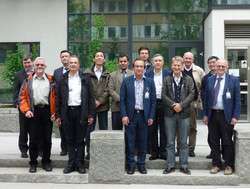TRISOFC coordinator Dr Mark Worall speaks about the project's unique fuel cell tri-generator which has the potential to increase the utilisation of available energy, reduce costs, add value, and decrease primary energy use and emissions.
Almost a half of the world's primary energy consumption is in the provision of electricity, heating and cooling. Most of this energy comes from centralised power stations where up to 70 % of available energy is wasted. The inefficiency of this model is unacceptably high, leading to considerable CO2 emissions and unnecessarily high running costs. These problems could be addressed if we move from conventional centralised power generation systems to efficient onsite micro-generation technology, and one promising possibility in this line is the solid oxide fuel cell (SOFC).
SOFC technology combines hydrogen and oxygen in an electro-chemical reaction to generate electricity, with the only by-products being water vapour, heat and a modest amount of carbon dioxide. Hydrogen can be supplied from hydrocarbon fuels such as natural gas, which is widely available for domestic and public buildings. For three years, the TRISOFC project team worked to advance this type of technology by developing a low-cost durable low temperature (LT) SOFC tri-generation (cooling, heating and power) prototype.
TRISOFC coordinator Dr Mark Worall from the University of Nottingham provided more specific details on the outcomes of the project, which officially concluded at the end of July: "The team designed, optimised and built an LT-SOFC tri-generation prototype, based on the integration of a novel LT-SOFC stack and a desiccant cooling unit." Additional components of the system are a fuel processor to generate reformate gas and other equipment for the electrical, mechanical and control balance of plant (BoP).
TRISOFC unique features
The TRISOFC's system boasts a number of unique features that set it apart from anything that has been done before. In particular, the operating temperature of the TRISOFC system is between 500 and 600 degrees Celsius, in comparison to normal SOFCs of 800 to 1000 degrees Celsius. "This is important," Dr Worall notes, "Because it enables BoP and other temperature dependent components to be manufactured from relatively low cost materials, such as stainless steel, and so potentially it substantially reduces costs of materials and components." Additionally, the LT-SOFC is based on a single component nanocomposite material, an invention of a team led by Professor Binzhu Zhu of KTH, one of the consortium partners, which is unique in that it can act as an anode, cathode and an electrolyte. Dr Worall adds, "Again, this has the potential to reduce costs and complexity and increase reliability and durability." Finally, the system has been integrated with an open cycle desiccant dehumidification and cooling system to provide heating, cooling and thermal storage. This has not been used before in fuel cells and it has the advantage of potentially increasing the utilisation of the waste heat (currently 40 % to 50 % of the total energy input is wasted).
Dr Worall notes, "In our system, the waste heat from the SOFC is used to re-concentrate the solution. This is a form of thermal storage, which allows us to operate the fuel cell when we don't need cooling and use it when we do. Our system has three main advantages: firstly, it increases the conversion efficiency of the SOFC from 45 % to 55% to potentially 85 % to 95 %; secondly, it reduces the demand for electrical energy that would be needed to provide comfort cooling (and by reducing electrical energy use, we are also reducing primary energy consumption and carbon dioxide emissions) and thirdly, it reduces cooling provided by vapour-compression refrigeration systems, which currently rely on working fluids that have a global warming potential (GWP) when released."
Putting the LT- SOFC tri-generation system to the test
The team has successfully proved the concept of a LT- SOFC tri-generation system. Dr Worall draws attention to two particularly significant test results: "Tests of two cell 6cm x 6cm LT-planar type SOFCs have shown power density of up to 1100W/cm² with of a power output of 22W, at 530 degrees Celsius. Researchers are in the process of developing 200We stacks and we should be able to demonstrate large scale, low temperature electrical output."
"Additionally, tests on the desiccant dehumidification system showed that a coefficient of performance (COP) of above 1.0 was achieved. COP is the ratio of the cooling output to the total energy input, and so represents a key performance parameter… In overall conversion term, our heat powered cooler is competitive with other systems."
TRISOFC impact
Now the concept has been proven, the next steps will be to prove long-term durability, scale-up production and reduce costs further. Dr Worall and the team expect the system developed under TRISOFC to have a significant impact on a number of levels: "This system is a first-of-its-kind fuel cell tri-generator and has great potential to increase the utilisation of the available energy, reduce costs, add value, reduce primary energy use and emissions and promote distributed energy production."
One group that could feel the benefits the most is consumers, as Dr Worall explains: "Most buildings use primary energy for heating, cooling and electricity, so by generating electricity at domestic level, consumers can potentially benefit from the sale of excess electricity production (depending on local energy costs, incentives and tariffs), reduce demand for heat for the provision hot water and heating, and the provision of electricity for cooling. As we are getting three for the price of one, consumers should benefit financially and in terms of reducing their impact on the environment."
The team is confident that both as an integrated system and as individual components the LT-SOFC tri-generation system has potential for commercialisation. "We are actively engaged with industry and end users to develop user-friendly, reliable and financial systems and subsystems," Dr Worall concludes.
More information: For further information, please visit TRISOFC: trisofc.com/
Provided by CORDIS























